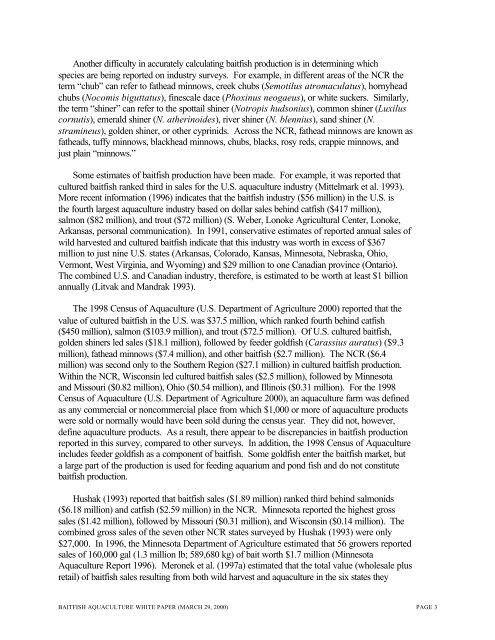a white paper on the status and needs of baitfish ... - NCRAC
a white paper on the status and needs of baitfish ... - NCRAC
a white paper on the status and needs of baitfish ... - NCRAC
You also want an ePaper? Increase the reach of your titles
YUMPU automatically turns print PDFs into web optimized ePapers that Google loves.
Ano<strong>the</strong>r difficulty in accurately calculating <strong>baitfish</strong> producti<strong>on</strong> is in determining which<br />
species are being reported <strong>on</strong> industry surveys. For example, in different areas <strong>of</strong> <strong>the</strong> NCR <strong>the</strong><br />
term “chub” can refer to fa<strong>the</strong>ad minnows, creek chubs (Semotilus atromaculatus), hornyhead<br />
chubs (Nocomis biguttatus), finescale dace (Phoxinus neogaeus), or <str<strong>on</strong>g>white</str<strong>on</strong>g> suckers. Similarly,<br />
<strong>the</strong> term “shiner” can refer to <strong>the</strong> spottail shiner (Notropis huds<strong>on</strong>ius), comm<strong>on</strong> shiner (Luxilus<br />
cornutis), emerald shiner (N. a<strong>the</strong>rinoides), river shiner (N. blennius), s<strong>and</strong> shiner (N.<br />
stramineus), golden shiner, or o<strong>the</strong>r cyprinids. Across <strong>the</strong> NCR, fa<strong>the</strong>ad minnows are known as<br />
fa<strong>the</strong>ads, tuffy minnows, blackhead minnows, chubs, blacks, rosy reds, crappie minnows, <strong>and</strong><br />
just plain “minnows.”<br />
Some estimates <strong>of</strong> <strong>baitfish</strong> producti<strong>on</strong> have been made. For example, it was reported that<br />
cultured <strong>baitfish</strong> ranked third in sales for <strong>the</strong> U.S. aquaculture industry (Mittelmark et al. 1993).<br />
More recent informati<strong>on</strong> (1996) indicates that <strong>the</strong> <strong>baitfish</strong> industry ($56 milli<strong>on</strong>) in <strong>the</strong> U.S. is<br />
<strong>the</strong> fourth largest aquaculture industry based <strong>on</strong> dollar sales behind catfish ($417 milli<strong>on</strong>),<br />
salm<strong>on</strong> ($82 milli<strong>on</strong>), <strong>and</strong> trout ($72 milli<strong>on</strong>) (S. Weber, L<strong>on</strong>oke Agricultural Center, L<strong>on</strong>oke,<br />
Arkansas, pers<strong>on</strong>al communicati<strong>on</strong>). In 1991, c<strong>on</strong>servative estimates <strong>of</strong> reported annual sales <strong>of</strong><br />
wild harvested <strong>and</strong> cultured <strong>baitfish</strong> indicate that this industry was worth in excess <strong>of</strong> $367<br />
milli<strong>on</strong> to just nine U.S. states (Arkansas, Colorado, Kansas, Minnesota, Nebraska, Ohio,<br />
Verm<strong>on</strong>t, West Virginia, <strong>and</strong> Wyoming) <strong>and</strong> $29 milli<strong>on</strong> to <strong>on</strong>e Canadian province (Ontario).<br />
The combined U.S. <strong>and</strong> Canadian industry, <strong>the</strong>refore, is estimated to be worth at least $1 billi<strong>on</strong><br />
annually (Litvak <strong>and</strong> M<strong>and</strong>rak 1993).<br />
The 1998 Census <strong>of</strong> Aquaculture (U.S. Department <strong>of</strong> Agriculture 2000) reported that <strong>the</strong><br />
value <strong>of</strong> cultured <strong>baitfish</strong> in <strong>the</strong> U.S. was $37.5 milli<strong>on</strong>, which ranked fourth behind catfish<br />
($450 milli<strong>on</strong>), salm<strong>on</strong> ($103.9 milli<strong>on</strong>), <strong>and</strong> trout ($72.5 milli<strong>on</strong>). Of U.S. cultured <strong>baitfish</strong>,<br />
golden shiners led sales ($18.1 milli<strong>on</strong>), followed by feeder goldfish (Carassius auratus) ($9.3<br />
milli<strong>on</strong>), fa<strong>the</strong>ad minnows ($7.4 milli<strong>on</strong>), <strong>and</strong> o<strong>the</strong>r <strong>baitfish</strong> ($2.7 milli<strong>on</strong>). The NCR ($6.4<br />
milli<strong>on</strong>) was sec<strong>on</strong>d <strong>on</strong>ly to <strong>the</strong> Sou<strong>the</strong>rn Regi<strong>on</strong> ($27.1 milli<strong>on</strong>) in cultured <strong>baitfish</strong> producti<strong>on</strong>.<br />
Within <strong>the</strong> NCR, Wisc<strong>on</strong>sin led cultured <strong>baitfish</strong> sales ($2.5 milli<strong>on</strong>), followed by Minnesota<br />
<strong>and</strong> Missouri ($0.82 milli<strong>on</strong>), Ohio ($0.54 milli<strong>on</strong>), <strong>and</strong> Illinois ($0.31 milli<strong>on</strong>). For <strong>the</strong> 1998<br />
Census <strong>of</strong> Aquaculture (U.S. Department <strong>of</strong> Agriculture 2000), an aquaculture farm was defined<br />
as any commercial or n<strong>on</strong>commercial place from which $1,000 or more <strong>of</strong> aquaculture products<br />
were sold or normally would have been sold during <strong>the</strong> census year. They did not, however,<br />
define aquaculture products. As a result, <strong>the</strong>re appear to be discrepancies in <strong>baitfish</strong> producti<strong>on</strong><br />
reported in this survey, compared to o<strong>the</strong>r surveys. In additi<strong>on</strong>, <strong>the</strong> 1998 Census <strong>of</strong> Aquaculture<br />
includes feeder goldfish as a comp<strong>on</strong>ent <strong>of</strong> <strong>baitfish</strong>. Some goldfish enter <strong>the</strong> <strong>baitfish</strong> market, but<br />
a large part <strong>of</strong> <strong>the</strong> producti<strong>on</strong> is used for feeding aquarium <strong>and</strong> p<strong>on</strong>d fish <strong>and</strong> do not c<strong>on</strong>stitute<br />
<strong>baitfish</strong> producti<strong>on</strong>.<br />
Hushak (1993) reported that <strong>baitfish</strong> sales ($1.89 milli<strong>on</strong>) ranked third behind salm<strong>on</strong>ids<br />
($6.18 milli<strong>on</strong>) <strong>and</strong> catfish ($2.59 milli<strong>on</strong>) in <strong>the</strong> NCR. Minnesota reported <strong>the</strong> highest gross<br />
sales ($1.42 milli<strong>on</strong>), followed by Missouri ($0.31 milli<strong>on</strong>), <strong>and</strong> Wisc<strong>on</strong>sin ($0.14 milli<strong>on</strong>). The<br />
combined gross sales <strong>of</strong> <strong>the</strong> seven o<strong>the</strong>r NCR states surveyed by Hushak (1993) were <strong>on</strong>ly<br />
$27,000. In 1996, <strong>the</strong> Minnesota Department <strong>of</strong> Agriculture estimated that 56 growers reported<br />
sales <strong>of</strong> 160,000 gal (1.3 milli<strong>on</strong> lb; 589,680 kg) <strong>of</strong> bait worth $1.7 milli<strong>on</strong> (Minnesota<br />
Aquaculture Report 1996). Mer<strong>on</strong>ek et al. (1997a) estimated that <strong>the</strong> total value (wholesale plus<br />
retail) <strong>of</strong> <strong>baitfish</strong> sales resulting from both wild harvest <strong>and</strong> aquaculture in <strong>the</strong> six states <strong>the</strong>y<br />
BAITFISH AQUACULTURE WHITE PAPER (MARCH 29, 2000) PAGE 3


